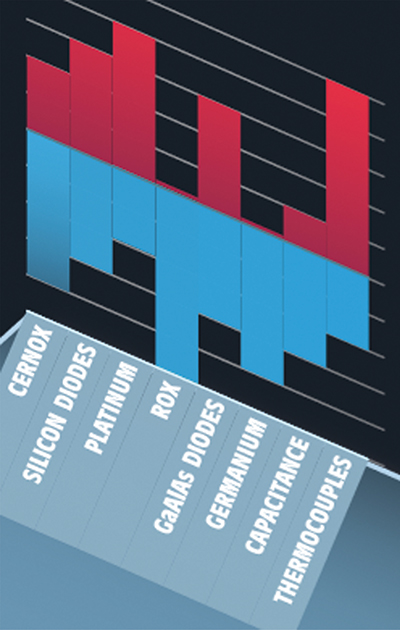Temperature sensor selection guide
To help you pick the right sensor for your application, each sensor has been given a rating for six attributes or characteristics: Temperature range, accuracy and resolution, magnetic resilience, radiation resilience, package options and price. These ratings can give you a general idea of how a sensor will perform and help you in your early decision-making process. However, they are no substitute for detailed specifications. For detailed information, please see the specification sheet. The attributes are a relative rating for comparison, not a quantitative measure.
Temperature range
It is important to select sensors that suit the temperature range of the intended system. The low-end temperature rating generally indicates where the sensor type starts to perform poorly, whereas the upper rating is the point where the sensor will begin to sustain permanent damage. So, if you are searching for the lowest temperature sensor possible a Rox sensor should be your first choice followed by Cernox, Germanium, Silicon diodes, GaAlAs diodes, Capacitance, Platinum and Thermocouples. On the high temperature side, the Thermocouple and the Platinum are leading, followed by Silicon diodes, GaAlAs diodes, Cernox, Capacitance, Germanium and Rox.
Accuracy and resolution
The accuracy and resolution rating for each sensor type considers the amount of uncertainty in the measurement by the sensor with regard to an absolute standard, as well as sensitivity over the temperature range of interest. Based on this criteria Cernox and Germanium are leading, followed by Silicon and GaAlAs diodes, Rox, Platinum, Capacitance and Thermocouples. Please be aware that sensors are very sensitive over narrow temperature ranges, but less sensitive in others.
Magnetic resilience
The Magnetic Resilience rating for each sensor type is a comparative rating of the sensor’s accuracy in magnetic field. The higher the rating, the less the sensor shifts when exposed to magnetic field. Capacitance is highest, followed by Cernox, Rox, Platinum, Thermocouples, GaAlAs diodes, Silicon diodes and Germanium. Please be aware that many sensors become resilient to magnetic fields at higher temperatures.
Radiation resilience
The radiation resilience rating is a measure of a sensor’s ability to withstand exposure to ionizing radiation. Sensors with a high rating will have a greater ability to stay within calibration after exposure. High-energy physics experiments and space applications often need to consider this variable. Highest radiation resilience offers Cernox, followed by Germanium, Thermocouples, Platinum, Rox, Silicon and GaAlAs diodes and capacitance.
Package options
Good thermal contact is vital when making cryogenic temperature measurements. Having a wide range of packaging options will make it easier to find a solution that is optimal for a given system. The package options rating is a measure of the number of available package options for a given sensor type. The most packaging options are available for Cernox, followed by Silicon diodes, Platinum, GaAlAs diodes, Rox, Germanium, Capacitance and Thermocouples.
Price
Each sensor type has been given a rating for price. This rating considers the total price of the sensor type without the addition of package options and should only be used as a tool to compare Lake Shore sensors. The higher the rating, the higher the price of the sensor. Thermocouples and platinum sensors are the cheapest, followed by Rox sensors, silicon diodes, capacitance and Cernox sensors, and GaAlAs diodes. Germanium sensors have the highest classification.
More details can be found in the “Temperature Sensor Selection Guide” brochure:




